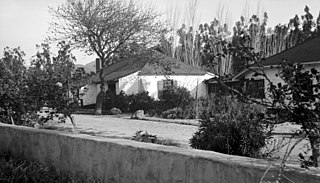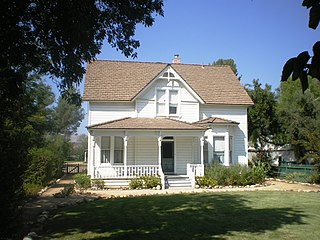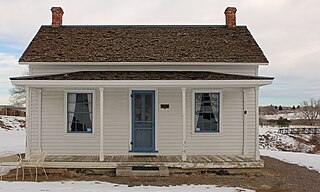
Norwalk is a city in Los Angeles County, California, United States. The population was 102,773 at the 2020 census.

California Citrus State Historic Park is an open-air museum in the city of Riverside, California, United States. As part of the state park system of California, it interprets the historic cultural landscape of the citrus industry. The park’s museum exhibits and interpretive features share the story of the citrus industry's role in the history and development of Southern California, and is told through the experiences of the diverse migrant and immigrant groups who made it all possible. The 248-acre (100 ha) park was established in 1993.

Rancho Camulos, now known as Rancho Camulos Museum, is a ranch located in the Santa Clara River Valley 2.2 miles (3.5 km) east of Piru, California and just north of the Santa Clara River, in Ventura County, California. It was the home of Ygnacio del Valle, a Californio alcalde of the Pueblo de Los Angeles in the 19th century and later elected member of the California State Assembly. The ranch was known as the Home of Ramona because it was widely believed to have been the setting of the popular 1884 novel Ramona by Helen Hunt Jackson. The novel helped to raise awareness about the Californio lifestyle and romanticized "the mission and rancho era of California history."

Bush's Pasture Park is a public park and botanical garden in Salem, Oregon, United States. It is the site of the Asahel Bush House, which was placed on the National Register of Historic Places in 1974, and is now operated as the Bush House Museum.

Los Cerritos Ranch House, also known as Rancho Los Cerritos or Casa de los Cerritos, in Long Beach, California, was "the largest and most impressive adobe residence erected in southern California during the Mexican period". Los Cerritos means "the little hills" in English. It was declared a National Historic Landmark in 1970. It is currently a museum.

The historic Simi Adobe–Strathearn House served as the headquarters of Rancho Simi, also known as Rancho San José de Nuestra Senora de Altagracia y Simi, one of the land grants in Alta California by the Spanish government. The name derives from Shimiji, the name of the Chumash village here before the Spanish. Rancho Simi was the earliest Spanish colonial land grant within Ventura and Santa Barbara Counties. At 113,000 acres, Rancho Simi was one of the state's largest land grants.

Camarillo Ranch House, also known as Rancho Calleguas and Adolfo Camarillo House, is a Queen Anne-style Victorian house in Camarillo, California. Built in 1892, the 6,000-square-foot (560 m2) house was designed by architects Herman Anlauf and Franklin Ward. Adolfo Camarillo operated the ranch for 78 years, changing the operations from mostly cattle to crops. He was a leading innovator, growing lima beans, barley, corn, alfalfa, walnuts, and citrus and eucalyptus trees. The house was added to the National Register of Historic Places in 2003.

The Rogue River Ranch is a pioneer farm complex in Curry County in southwest Oregon, United States. The ranch is located on the north shore of the Rogue River just outside the Rogue River-Siskiyou National Forest. The original ranch buildings were constructed by George Billings. Later, the ranch was sold to Stanley Anderson, who increased the size of the property and built additional farm buildings. The Bureau of Land Management bought the ranch in 1970. Today, the main ranch house is a museum. The Bureau of Land Management also maintains a campground on the property. The Rogue River Ranch is listed on the National Register of Historic Places.

Edgemoor Farm Dairy Farm was built as part of a dairy farm in 1913 in Santee, California. Edgemoor was part of a Spanish land grant to Maria Antonio Estudillo who married Miguel de Pedrorena, a native of Madrid. By the 1850s, through a variety of ways, individuals obtained portions of the grant and began to farm. Walter Hamlin Dupee purchased Edgemoor Farm in 1913 and built it into a national award-winning dairy farm, polo pony ranch and early tourist attraction.

Oaklawn Garden, also known as Oaklawn Gardens, is a botanical garden, park and museum located at 7831 Old Poplar Pike in Germantown, Tennessee, United States. A historic residential home, erected by the original landowner in 1854, is situated on the property.

The James Cant Ranch is a pioneer ranch complex in Grant County in eastern Oregon, United States. The ranch is located on both sides of the John Day River in the John Day Fossil Beds National Monument. The ranch was originally homesteaded by Floyd Officer in 1890. Officer sold the property to James Cant in 1910. Cant increased the size of the property and built a modern ranch complex on the west bank of the river. The National Park Service bought the ranch from the Cant family in 1975, and incorporated the property into the John Day Fossil Beds National Monument. The National Park Service used the main house as a visitor center until 2003. Today, the Cant Ranch complex is preserved as an interpretive site showing visitors an early 20th-century livestock ranch. The James Cant Ranch is listed on the National Register of Historic Places.

The Old Borges Ranch is a 1,035 acres (419 ha) historic district in the Mt. Diablo foothills within the 2,600-acre (1,100 ha) Walnut Creek Open Space in Contra Costa County, California. A former cattle ranch, Old Borges Ranch includes multiple historic buildings, a ranger station, farm animals, and access to trails.

The Gully Homestead is a former homestead located at 200 S. Chambers Road in Aurora, Colorado.
The Hathaway Ranch & Oil Museum in Santa Fe Springs, California is a museum of five generations of Hathaway family and Southern California history. The five-acre facility includes hundreds of artifacts and buildings showing the initial usage of the land in farming and ranching, as well as the major transition when oil was discovered in the area.

The Samuel Gilbert Smith Farmstead is a historic farm property at 375 Orchard Street in Brattleboro, Vermont. The present 20-acre (8.1 ha) property includes a well-preserved 1870s-era connected farmstead and other 19th-century landscape features. Associated with the property are a well-documented history of the transformations the property has undergone since its 18th-century origins. The property was listed on the National Register of Historic Places in 2000.
The Swanton Pacific Railroad Society operated an historic one-third scale, 19 in gauge, railroad at Swanton Pacific Ranch in Davenport, California, 15 miles (24 km) north of Santa Cruz, California. The one-mile (1.6 km)-long railroad lies along the Ocean Shore Railroad right-of-way that was to run from San Francisco to Santa Cruz. The scenic trip, through a valley in the coastal mountains, crosses Scott Creek on the Ed Carnegie Bridge, passes a Christmas tree farm, and ends at a wye where passengers observe railroad operations that turn the locomotive.

Newland House is an 1898 farmhouse in a midwestern adaptation of a Queen Anne architectural style in Huntington Beach, California, listed on the National Register of Historic Places. It is one of 123 historic places and districts on the National Register of Historic Places in Orange County, California. The Newland House is listed as the ninth historic place to receive a historical plaque from the Orange County Historical Commission in cooperation with the Orange County Board of Supervisors. The house has been identified as the site of the Tongva village of Lupukngna.

Mission Ranch is a historic hotel and restaurant in Carmel, Monterey County, California, United States. It is located in the unincorporated Mission Tract south of the incorporated city of Carmel-by-the-Sea, near the Carmel Mission, at 26270 Dolores Street. The property was bought in 1986 by Clint Eastwood, who restored the premises in the style of the original buildings. The hotel has 31 rooms located within ten buildings on the property.























